Places of Worship in Whitfield
Littlemoor Chapel, Whitfield.
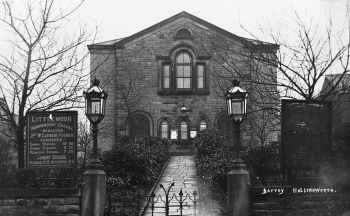
The chapel opened in 1811 on land given by Samuel Dearnally of Crosscliffe,. The first Trustees being George Hadfield, Moses Hadfield, John Kershaw, William Kershaw, Thomas Shaw, James Shephard and John Platt. The chapel was enlarged at a cost of over £1,000 in 1845. A new organ for the chapel was purchased in 1924 and in 1927 Choir stalls were erected. In 1949 the chapel closed for decorating, re-opening the following year 1950. In 1956 Littlemoor and Brookfield chapels came together for joint Pastorship under the care of Rev. W. E. Joseph.
The graveyard containing 3,000 bodies was exhumed and re-interred at Glossop Municipal Cemetery in April 1976 and a memorial stone to those once buried at Littlemoor can now be seen there.
The Chapel eventually closed and is now used as a Fitness Centre.
The chapel had its own war memorial.
Hague Street Methodist Chapel, Whitfield.
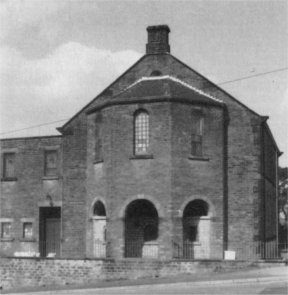
The original Chapel was opened on 26th October 1813 on land leased for 999 years at a rent of 11s. 3d. per annum. In 1832 a Sunday School was built and later rebuilt in 1865. In 1885 the old Chapel was demolished and the foundation stone for the new Chapel was laid on 6th June 1885. The Chapel continued in use until 1931 when the Chapel and Sunday School were rebuilt to form the present building. The Chapel closed after Easter Sunday 1968.
St. James C of E, Whitfield.
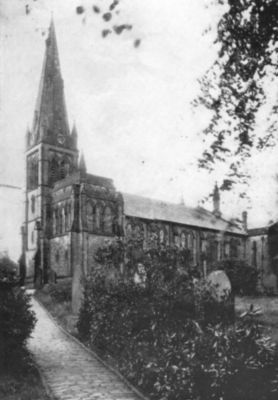
Whitfield was constituted a parish in 1844 under Sir Robert Peel's Act, and included Hadfield, part of Padfield, Dinting and Chunal. The Church was built by voluntary contributions aided by grants. The first stone was laid on 27th September 1844 and the church was consecrated on 8th September 1846.
The church was built in the early English style, with nave, chancel, side aisles, and transepts, a tower and spire 114 feet high, from designs by E. H. Shellard, Esq., of Manchester; the interior including the chancel, 82 feet 7 inches by 50 feet 8 inches: it will contain 1000 sittings, of which one-half are free, having carved stall ends. The gallery at the west end is for an organ and school children. The principal or west entrance has clustered pillars, arches with carved heads, above which is a colonnade of pillars and arches, finished with an oriel window. It has also a north door; the approaches to the galleries is by a geometrical stone staircase in the tower. The east end gables are surmounted with octagon turrets and carved finials, it is lighted by a triple window, and the other parts by double narrow windows. The tower is mounted with pinnacles, and has a bell 450lbs. weight and the spire with lucarnes, carved canopies and finial. The estimated cost, £4,500, of which sum £2,000, was raised by subscription, and £2,500 by grants from various societies.
The church has its own war memorial.
A detailed history is provided in the Whitfield St. James Church, Centenary 1946.
Ebenezer Methodist Chapel, Whitfield.

Ebenezer Chapel, Whitfield was built in 1854 as a place of worship for a Society of Wesleyan Reformers. The land was leased from the Duke of Norfolk. The Chapel was opened on 20th August 1854 by Rev. James Everett. The centre pews were added shortly after opening and later a gallery was added. In 1879 a boiler was installed and two vestries constructed. The Sunday School was built in 1899. In 1920 electric lighting was installed at a cost of £80. In 1927 the land was bought from the Howard Estate for £108. The Chapel closed and later the building was used for Glossop Whitfield Youth Centre meetings, this opened on Saturday April 4th 1964.
Mount Pleasant Congregational Church.
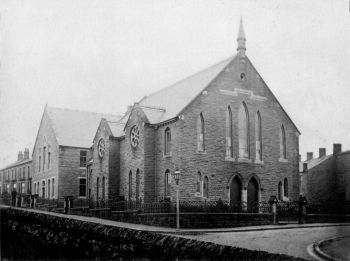
The foundation stone was laid on May 23rd 1868 by Henry Lee Esq. of Manchester with the Rev. G. Conder, Professor F. S. Williams and the Rev. R. Stanton taking the Ceremony. The church was opened twelve months later. On Good Friday 1875 the foundation stone of the Sunday school was laid and on 17th November 1896 an organ was installed and dedicated. The Church is now closed.
The church had its own war memorial.
St. Mary Crowned Roman Catholic Church, Sumner Street, Glossop.
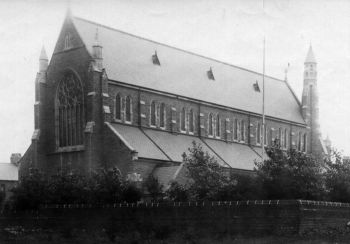
The Church was erected on a site donated by Lord Howard and was paid for by Francis James Sumner. The Church was officially opened and consecrated by Dr. Bagshawe, Bishop of Nottingham on 18th August 1887. The architecture is Early English style with chancel, nave and north and south aisles. The nave measures 30 feet wide by 120 feet long by 70 feet high. The north and south aisles are 15 feet wide by 120 feet long and the chancel measures 24 feet by 27 feet with an octagonal apse. The nave is separated from the aisles on each side by eight hand carved stone pillars. The sanctuary is a pentagonal apse and on each side is a small chapel separated from the sanctuary by a carved stone screen surmounted by angels. The high altar is a piece of sculpture in Caen stone, the centre piece being The Last Supper, on either side the Crucifixion and Burial of our Saviour. Behind the altar is the Reredos sculpture in Caen stone of the Assumption of the Virgin Mary into heaven supported by angels, on either side Moses and the serpent and the Israelites being fed manna in the desert.
This Church is still in use today.
The church has its own war memorial.
Princess Street Chapel, Whitfield.

The Princess Street Chapel - the only one on the Methodist Circuit not built with stone - was erected in 1893, shortly after the closing of a small chapel at Charlesworth, and represented an extension of the work of the Shrewsbury Street Chapel. It was built of Wood and had a corrugated iron roof. The Chapel closed on 28th August 1960 and the congregation went to Shrewsbury Street Chapel, Glossop. In October 1961 the building was converted into a Scout Hut.
Return to GJH.me Home Page, Return to Glossop Area Local Histories index.
Last updated: 12 December 2021






